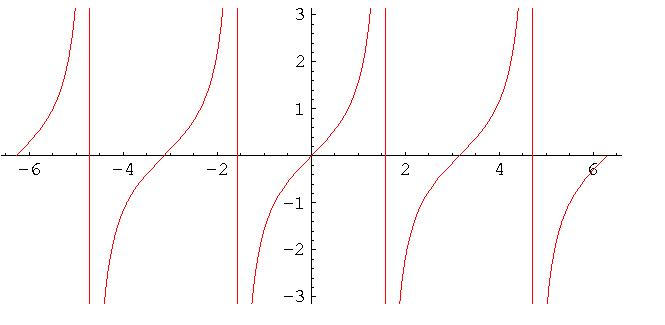
Name:
Directions: Show your work! Answers without justification will likely result in few points. Your written work also allows me the option of giving you partial credit in the event of an incorrect final answer (but good reasoning). Indicate clearly your answer to each problem (e.g., put a box around it). Good luck!
There are twelve 10 point problems. You may skip two - write ``skip'' on them. If you do not write ``skip'' on a problem, I will pick them at random to skip - so it's better that you choose!
Problem 1 (10 pts). Given the graph of a portion of the tangent function,

Problem 2 (10 pts). Consider the function
![]()
Problem 3 (10 pts). Hyperbolic trigonometric functions.
![]()
Problem 4 (10 pts). Study the function
![]()
including details about the domain, range, symmetry, asymptotes, continuity, differentiability, max/mins, inflection points, etc. Use your calculator as needed.
Problem 5 (10 pts). Use L'H ![]() pital's rule (if appropriate) to
compute the following limits:
pital's rule (if appropriate) to
compute the following limits:
![]()
![]()
![]()
Problem 6 (10 pts). Use the limit definition of the derivative to show that
![]()
Problem 7 (10 pts).
Consider the region bounded by the function ![]() ,
the x-axis, and the line
,
the x-axis, and the line ![]() , and the solid obtained by
rotating this region about the y axis. You
are to set up the integral for the volume of the solid using two methods:
, and the solid obtained by
rotating this region about the y axis. You
are to set up the integral for the volume of the solid using two methods:
Problem 8 (10 pts). If the work required to stretch a spring 1 ft beyond its natural length is 12 ft-lbs, how much work is needed to stretch it 9 inches beyond its natural length? (Draw a picture, write Hooke's law, and solve!)
Problem 9 (10 pts). Find the tangent line to the curve of the function
![]()
when t=1. Draw the curve and its tangent line at that point.
Problem 10 (10 pts). Use substitution to solve the following integrals:
![]()
![]()
Problem 11 (10 pts). True/false (feel free to explain any answer - you might get partial credit even if you're wrong!):
linear when x gets very large (positive).
![]()
then f(a)<f(b).
on the interval [a,b] is given by
![]()
Problem 12 (10 pts). A woman wants to design a rectangular garden with an ornamental fence on 3 sides which coses $3/foot. The back fence costs only $1/foot and she has only $200 to spend. What dimensions will allow a maximum area for the garden?